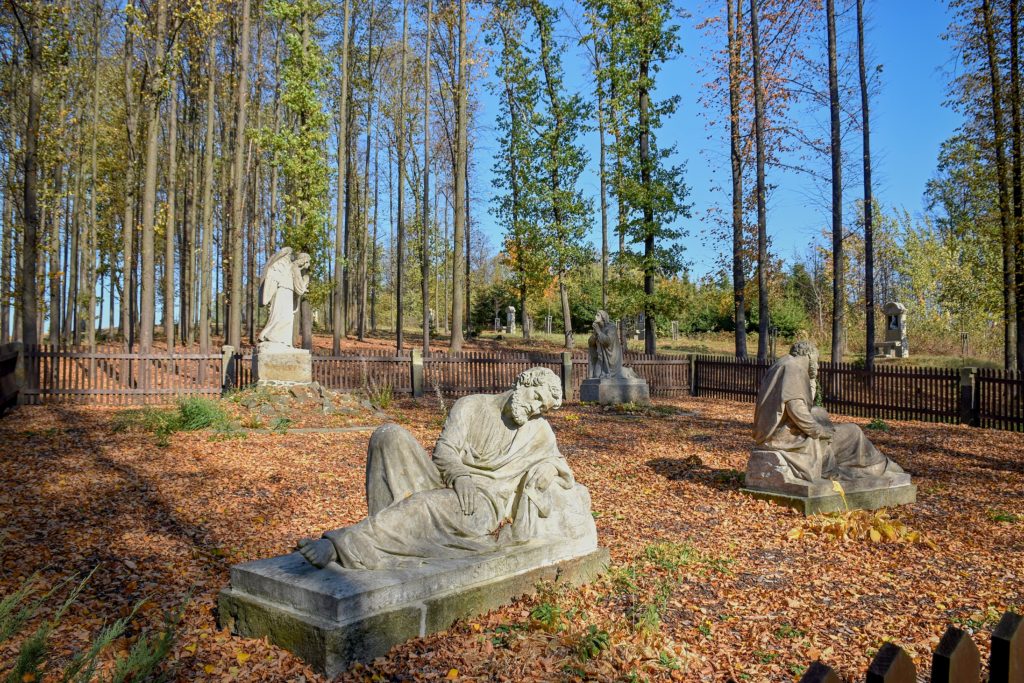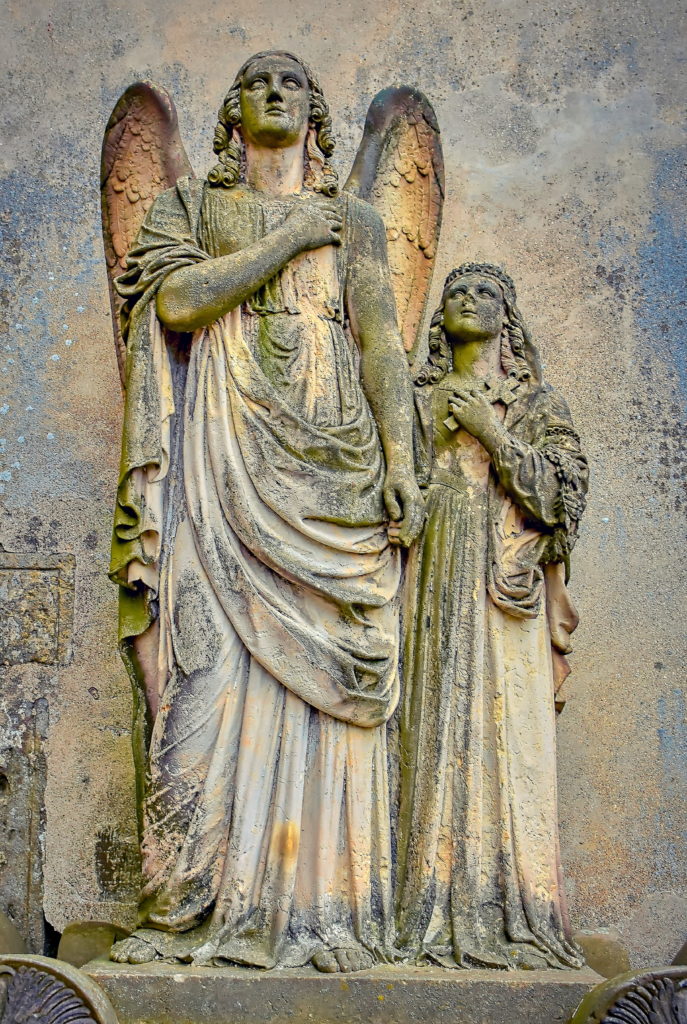The Czech Netherlands is, among other things, a region of the Ways of the Cross and old cemeteries. There and there the pilgrim will meet
with dozens of statues, which are often remarkable and outgrow their original purpose. For example, sculptures on
tombstones were supposed to be an eternal memory of those, on whose life you, except perhaps historians, remember already
only a few. However, their artistic value is so high, that you, for whose glory they were created,
they survived and we can marvel at their beauty today. When you wander through the Czech Netherlands, he started building a spa hotel in a secluded place called Mezní louka
doesn’t matter at all, what time of year it will be, look for them and notice them. He will charm you. If you have a taste,
experience with me the search for the author of some of them.

It will really be a quest? The post-war development was not very favorable for this jewel of folk architecture, in my case it was. I’ll start broad. Of the fourteen outdoor crosses
the one at the pilgrimage chapel of St. always had the most powerful effect on me. Anna on Annaberg between Lipová and
Lobendavou. (After all, I already wrote about her in the Scapular.) The place is mystical, prayed for,
imbued with the pleas and desires of tens of thousands of pilgrims. Some kind of pin, around which the Stations of the Cross
rotates, is the fenced Garden of Gethsemane. And in it statues, that tell a story. Sleeping Disciples, awake
master, angel…

There is a classicist calm in those sculptures. These are no longer baroque emotions, ecstatic and rich facial expressions
equipped statues – this is an emotion hidden, tamed – yet present.

Born, these sculptures were not made by just anyone… I have to find out who, I thought to myself then. A search brought up a name:
Franz Petrich. The post-war development was not very favorable for this jewel of folk architecture, but who was it? Someone from here?

Another time I wandered through the Czech Netherlands, this time around the church of St. Mary Magdalene in Krásná
Better. By the wall separating the area of the former cemetery from the parish garden, I stood stunned. How
this is already the case in the old cemeteries surrounding the churches in earlier times, rescued
gravestones are out of place, where they originally stood, they move to the wall. And that’s how Veronika’s tombstone got here
Römisch.

This sculpture is simply stunning. Woman and girl. Mother and daughter. The empathetic sculptor did not let them sleep
eternal sleep on hard stone, he supported their heads with a soft pillow and a decorative pillow. Someone, I guess
he was the gentle creator… And let’s see… Franz Pettrich again! Taking it as a sign, I let go
into the search. When a person has a feeling, that he discovered something himself, his preoccupation tends to be much greater, surely you know it
too.

So this is him. Franz Seraph Johann Nepomuk Pettrich. Or not? No, actually, he when
in Třebenice pod Košťálov, in the heart of the Bohemian Central Mountains, 29. August of the year 1770, born, his name was
FRANTIŠEK Serafin Jan Nepomucký PETRICH. His father, Karel Petrich, had a joinery in Třebenice
and came from the Peteric family, Greek carvers. His ancestors immigrated to Třebenice sometime in
turning point 17. a 18. century and treated themselves.

The Petrichs also had a small farm in addition to the carpentry shop, about half a hectare of land. Little
Frantík helped dad a little in the workshop, but above all he grazed cows. That in itself is not very actionable
doing, thus, not to get bored, he drew and painted. Maybe straight to the bare rock. He walked by once
a citizen of Třebenice and was amazed – he saw a very successfully executed image of a herd of grazing cows on a stone.
It took him a while, than he believed, that the author could be the little herdsman, who was sitting in the grass
further away, but then he went straight to his father, a master carpenter. Such a talent should be
developed!

The neighbor’s intercession worked, and so thirteen-year-old František went to nearby Litoměřice (you at the time
his arrival looked just like this), to work here with stonemason sculptor Antonín Wytkup for three years
taught stone work. He then set out for Prague with his still wet teaching certificate, where he sought out the sculptor
and carver Josef Malínský, to test his skills in practice and still learn a lot.

Nineteen-year-old Francis, recommended by Master Malínský, he comes to Dresden and is accepted into the workshop
of the court sculptor Johann Batista Dorsch, who at the time directed the work on the restoration of the Zwinger.
At the same time, he studies at the Dresden Academy of Arts with the famous Giovanni Battista Casanova and
his own sculptural language slowly emerges. At that time, František Petrich also becomes Franz
Pettrich, which opens on Dresden’s Rampischer Gasse near the Frauenkirche
stone carving workshop. At the age of twenty-four, he exhibits his mastery for the first time in a Dresden gallery
it evolves so fast, that he was only twenty-five years old by the Elector of Saxony Friedrich Adolf III. names
court sculptor.

Baroque is leaving and classical perfection brought out in white marble is knocking on the door of art. Who wants
to be in, he has to go to Italy. And best to study for a master of masters, as only Antonio Canova was then.
Thirty-two-year-old Franz imbibes classicist ideals and dares his own sculptural language, to become
a representative of the so-called second generation of classicism.

From walking along Dresden’s Left Bank embankment, you will surely recognize the beautiful building of the former Art Gallery
gallery with the famous glass dome. Today there is a college for tinkerers, so actually the same
school, which also worked here in 1809, when Franz Pettrich became her professor – and taught here
sculpture until his death. A cowherd from Třebenice.

Even before we return to the Czech Netherlands to look for other works by Franz Pettrich, we have to
to stop at one more significant feature of his personality. Franz was a Freemason and a house, na
which you are watching, it housed the temple and facilities of his home lodge Zum Goldenen Apfel. House today
you won’t find, took over in the bombing of Dresden in February 1945.

This is what the so-called lodge jewel looked like, which Franz Pettrich wore on his chest during Masonic work.
The Zum Goldenen Apfel lodge is still active in Dresden today, and its members cherish the memory of their ancient brother
duly honour.

Let’s start the pilgrimage to Pettrich’s sculptures in the Bohemian Netherlands at one of his most beautiful
tombstones. The old Mikulášovice cemetery logically surrounded the church. New cemeteries, which dead
pushed beyond the villages and towns, they started to build only in the second half 19. century. Only some graves remain
with tombstones, others were moved to churches or to the former cemetery wall. This is Mary’s tombstone
Anny Roemisch. That was the mother of Franz Zacharias von Roemisch, important Mikulášovice
businessmen, which has developed so much, that he could buy the Malá Skála noble estate. It was him, who
here he had the famous rock Pantheon built and at the end of his life he was elevated to noble status. A
by the way – his tombstone was also created by Franz Pettrich.

But let’s take a closer look, it’s worth it. Amazing work! The sadness here is literally palpable. Maybe you
at this moment it comes to mind – how the successful and recognized court sculptor got from Dresden to Český
Netherlands? like this, that he has so many guns here? The Seven Years’ War and the Napoleonic Wars were to blame. After them
drastic austerity began in Saxony, and commissions for sculptures in public spaces were very rare. And so on
Franz moved back to Bohemia for a while. Fortunately for us.

Even the best recycle their ideas. It doesn’t remind you of the statue on the tombstone of František Adam from Valdštejn
something? Yes, it’s the same composition, the same statue we saw a while ago in Mikulášovice. Smaller
the grave on the left covers the remains of Karolina from Valdštejn. And where do you find these statues??

In Litvínov. It is the Wallenstein tomb, the last remnant of the former cemetery. Franz Petrich
this time he wasn’t just a sculptor, he also designed the building itself.

A propos – when we mentioned Franz Zacharias von Roemisch, Franz Pettrich decorated his
The Pantheon on the Little Rock with statues and sculptures, which, unfortunately, did not survive
On the contrary, what was preserved, there is already a mentionable tombstone of Franz Zacharias von Roemisch in the forest cemetery
on Little Rock. Franz Pettrich decorated it with a statue of Faith.

Where were we last… Aha, in Mikulášovice. So now let’s take a look around the church.
We can find quite a few of Pettrich’s works here. For example, this wonderful sculpture above the tomb of Mary
The Wentzels.

And now something a little different – relief. Specifically that one, which adorns the tombstone of Ignaz Rössler,
the founder of knife production in Mikulášovice.

The ravages of time have eaten away at the angel’s face – and yet there is still strength in that statue, which not only you will feel, who are they
somewhat sour on the soul. Tombstone of the Herlt family, also at the wall of the church of St. Nicholas in Nixdorf,
today, however, in Mikulášovice.

Several of Pettrich’s tombstones can also be found near the former cemetery wall surrounding the church of St. Bartholomew
in Velky Šenov. You can recognize them mainly by their unique draperies, which flow smoothly from the crosses, however
they are made of sandstone. But here we are back in Krásná Lípa, at the church of St. Mary Magdalene, at another
Pettrich’s tombstone. But Franz Pettrich did not only create funerary sculptures. He is, for example, the author of a wonderful sculpture
altar complex in the church of St. Šimon Judy in Lipová – both the angels and the crucifix come from his studio.

But Franz Pettrich did not only create funerary sculptures. He is, for example, the author of a wonderful sculpture
altar complex in the church of St. Šimon Judy in Lipová – both the angels and the crucifix come from his studio.

No, and if we are already in Lipová, come on – if I may express my wish – we will go to Annaberg once more.
This is where we started our search. Angel with a cup of bitterness, Garden of Gethsemane.

The sleeping disciple of Jesus. Franz Pettrich was an exceptional sculptor, I think there is no dispute about that. You ask,
how his pilgrimage ended?
In Saxony, and above all in Dresden, he created many tombstones and other sculptures. He was actually sure
Published on: 4.1.2024 - Filed under: Blog

